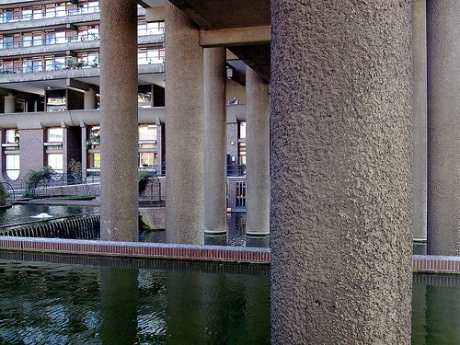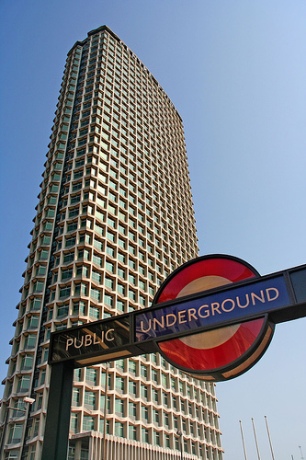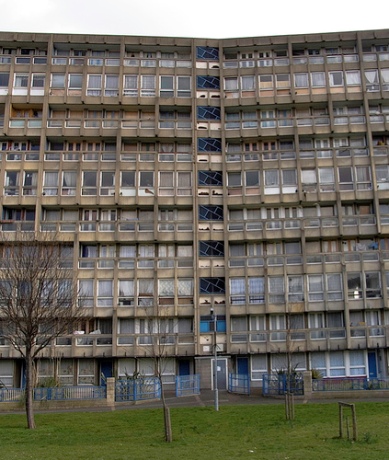London Hotels Insight provides up-to-date, independent advice for your perfect stay in London. We research guest feedback, meet management and identify hotels at the top of their game.
London’s ugliest buildings.

Many would call the Barbican "ugly" but it does have its own eerie appeal and was seen as cutting-edge in its time (image credit below)
Prince Charles famously called the design for the new Sainsbury wing of the National Gallery a ‘monstrous carbuncle’. And everyone has their own view of Centre Point, the Barbican, the Gherkin, and other London landmarks derided for their ugliness. ‘Ugly’ buildings do though have a great history.
For instance the great Baroque architect, Nicholas Hawksmoor set up a number of quite fascinating ‘ugly’ buildings.
Look at St Mary Woolnoth in the City for example – already featured as part of our series on London’s secret churches – with its brutally cubist approach and deeply-carved rustication. There’s nothing appealing or pretty about this church – it’s full-frontal, “in-your-face” architecture.
The same architect’s Christ Church in Spitalfields is more elegant but just as uncompromising in its verticality. Its glistening spire soars heavenwards, complemented by the single huge dark hollow of the arch in the façade.
When Hawksmoor got hold of an idea, he followed it wherever it went – whether the result was conventionally pretty or not. Take a tour round his London churches and it might change your views of architecture for ever.
Centre Point (where Tottenham Court Road and Oxford Street meet) is renowned as an ‘ugly’ monstrosity but not just due to the building itself.

The problem with Centre Point is the chaotic arrangement underneath the building (image credit below)
In fact, the curves and corrugations of its svelte skyscraper outline set up a pleasing rhythm and the proportions are quite elegant.
What is hard to accept though is the dumb way the building interacts with the street – the fact there’s no pavement on that side of the road and the way the tower doesn’t come down to street level so that the line is broken by the odd supports and gloomy underpass underneath the bottom.
It’s a totally inconvenient and slightly mad set-up – as anyone who has tried to cross the road there will tell you! It will though probably improve once the Crossrail development has opened up the Centre Point plaza.
The Barbican (pictured above) is another so-called ‘ugly’ structure which is in fact oddly likeable. Its huge towers – stark and strong – dominate the City skyline, prickling with balconies.
The lower-rise terraces either side of the huge rectangular pond create a brilliant contained space in the city, where greenery and water humanise the built environment. Some call it architecturally ahead of its time.
Where the Barbican falls down though is in the way you can never get from A to B – you have to go all round the houses, moving up or down levels, taking bridges or stairs or galleries. It’s a highly confusing place and some of the pedestrian routes are pretty dismal as well.
“The Gherkin” or Swiss Re building is the latest recipient of opprobrium.
But again it’s not as bad as it’s made out to be. Its geodesic panels give it a certain style, with their wonderful curves, its glimmering glass skin.

The Swiss Re Building ("The Gherkin") - is another London landmark you'll either love or hate (image credit below)
And it’s like nothing else in London – “a real character” and not another boring block. So although it doesn’t conform to the conventional canon of good taste, it still feels like a worthwhile addition to the skyline.
Elephant & Castle shopping centre on the other hand is a building that nothing and nobody can save. That is partly because it has no sense of display whatsoever despite being placed on a traffic island. It’s just deadly dull and probably wins the award for ‘ugliest building in London.’
Ultimately, though, many of the buildings that people label as “ugly” are at least striking, full of character and individual.
The erotic Gherkin has its fans – as does Robin Hood Gardens – a brutalist housing estate in East London whose stark concrete lines have a certain aesthetic appeal but which is currently slated for demolition.

Robin Hood Gardens has as many "fans" as enemies - proving how subjective the idea of "ugly" really is (image credit below)
The truly horrible buildings are the boring Lego houses of modern estates – the office slabs that are just boxes with windows in – the pastiche terraces of chi-chi housing developments and fake-Georgian houses wrong in every detail (wrong proportions, wrong windows, wrong doors, wrong bricks!).
The buildings that pull architecture down to the level of packaging and which have no character and integrity – those are the real ugly buildings. But somehow they’re the buildings no one bothers to protest about.
So let’s celebrate “real ugliness”! And enjoy those buildings that actually have the guts to offend us!
On a related topic, what about London’s ugliest hotel? A number of rather unpromising buildings in the city do in fact house some quite decent hotels.
Do read the next instalment of this article to find out more.
The above article was contributed by guest writer Andrea Kirkby.
Get the best-value London hotel deal from 30+ booking sites in 1 click
Photo credits: Maurice Koop’s photostream, suburbanslice’s photostream, rudolf_schuba’s photostream, joseph beuys hat’s photostream.
Previous post: The best accessible London hotel rooms.
Next post: London’s most boring hotel buildings.































{ 1 trackback }
{ 0 comments… add one now }